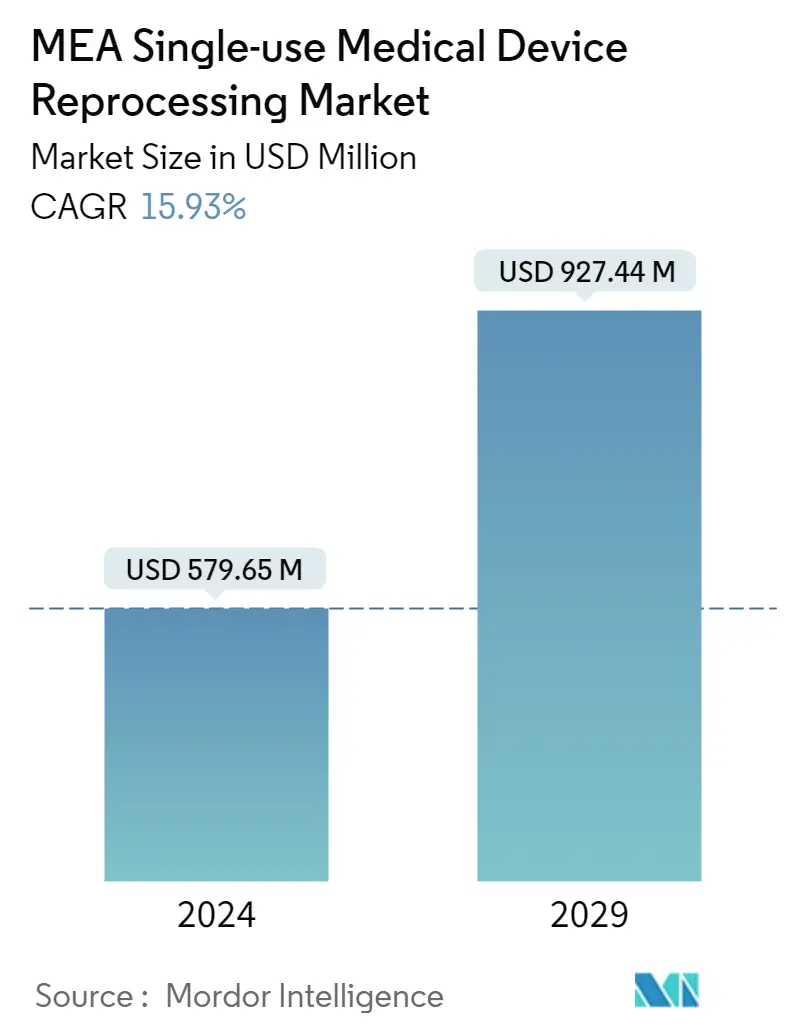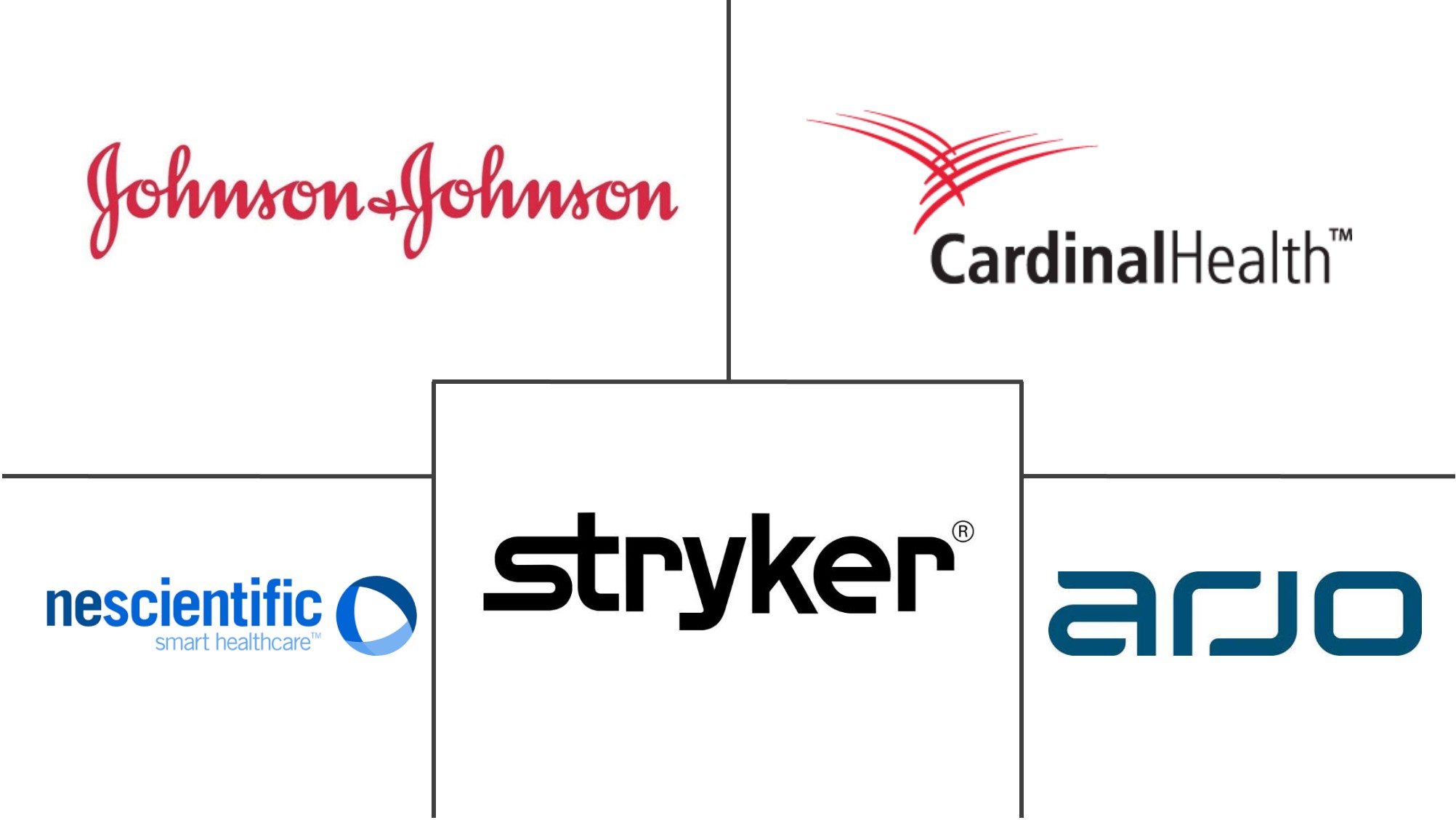Market Size of MEA Single-use Medical Device Reprocessing Industry

| Study Period | 2019 - 2029 |
| Market Size (2024) | USD 579.65 Million |
| Market Size (2029) | USD 927.44 Million |
| CAGR (2024 - 2029) | 15.93 % |
| Fastest Growing Market | Middle East and Africa |
| Largest Market | Middle East and Africa |
Major Players
*Disclaimer: Major Players sorted in no particular order |
Middle East and Africa Single-use Medical Device Reprocessing Market Analysis
The MEA Single-use Medical Device Reprocessing Market size is estimated at USD 579.65 million in 2024, and is expected to reach USD 927.44 million by 2029, growing at a CAGR of 15.93% during the forecast period (2024-2029).
The COVID-19 pandemic significantly impacted the MEA single-use medical device reprocessing market due to the high burden of medical device wastage from various healthcare centers in the Middle East and Africa region. For instance, the Multidisciplinary Digital Publishing Institute article published in November 2022 mentioned that solid waste generation from healthcare facilities, which included personal protective equipment and medical devices, significantly increased from 70 to 300 tons per day during the COVID-19 pandemic. Such a high number of medical devices generated due to the pandemic had a notable impact on the demand for single-use medical device reprocessing, affecting market growth. In addition, the need for single-use medical device reprocessing is expected to remain intact in the Middle East and Africa due to the rising concerns over high medical wastage post-pandemic, thereby contributing to the growth of the market studied over the forecast period.
Factors such as cost savings through reprocessing single-use medical devices, increasing regulatory pressure to reduce the volume of medical waste, the rising burden of chronic diseases, and the growing geriatric population are expected to boost the market studied. According to the report published by BioEnergy Consult in March 2022, between 15-25% of the total amount of medical waste created in the Middle East is considered hazardous or infectious. This remains a serious and pressing health problem for the region. In particular, the use of single-use medical devices like syringes and needles in hospitals and clinics is much more significant when compared to standard devices in Middle Eastern countries. Hence, proper medical waste management is crucial, which can be achieved through medical device reprocessing.
The cost-effectiveness of single-use medical device reprocessing is also expected to contribute to the market's growth. For instance, the South Africa Medical Journal published in April 2022 mentioned that single-use medical device reprocessing would reduce healthcare costs by USD 540 million annually. Such cost-related advantages are expected to boost the demand for single-use medical device reprocessing, fuelling market growth. However, potential material alteration during reprocessing, cross-infection with reprocessed devices, and a general notion regarding the quality of reprocessed single-use medical devices among healthcare providers are expected to impede the growth of the market studied.
Middle East and Africa Single-use Medical Device Reprocessing Industry Segmentation
As per the scope of the report, single-use device (SUD) reprocessing includes the cleaning, disinfection, sterilization, testing, and restoration of the technical and functional safety of used devices. The reprocessing of SUDs makes it possible for hospitals to maintain patient care quality while saving substantial amounts of money. The Middle East and Africa single-use medical device reprocessing market is segmented by device type (class I devices (laparoscopic graspers, scissors, forceps, scalpels, tourniquet cuffs, and other class I devices) and class II devices (pulse oximeter sensors, sequential compression sleeves, catheters, guidewires, and other class II devices)) and geography (GCC, South Africa, and Rest of Middle East and Africa). The report offers the value (in USD) for the above segments.
| By Device Type | ||||||||
| ||||||||
|
| Geography | |||||
|
MEA Single-use Medical Device Reprocessing Market Size Summary
The Middle East and Africa single-use medical device reprocessing market is poised for significant growth, driven by the increasing need to manage medical waste and reduce healthcare costs. The COVID-19 pandemic highlighted the issue of medical waste, with a substantial rise in waste generation from healthcare facilities, which has spurred demand for reprocessing solutions. The market is supported by factors such as regulatory pressures to minimize waste, the rising prevalence of chronic diseases, and a growing geriatric population. These elements are expected to bolster the adoption of reprocessing technologies, which offer cost-effective alternatives to traditional waste management practices. Despite challenges like potential material alteration and concerns over the quality of reprocessed devices, the market is set to expand as healthcare providers seek to balance cost savings with patient safety.
In the Gulf Cooperation Council (GCC) region, countries like Saudi Arabia and the United Arab Emirates are leading the charge in adopting single-use medical device reprocessing due to their advanced healthcare infrastructure and high medical waste generation. The demand for reprocessing is further fueled by the increasing number of surgical procedures and the prevalence of infectious diseases, necessitating efficient waste management solutions. Key players in the market are actively engaging in collaborations and innovations to enhance their offerings, ensuring compliance with stringent infection control regulations. As the market continues to evolve, the focus on sustainable healthcare practices and cost reduction is expected to drive the growth of single-use medical device reprocessing across the Middle East and Africa.
MEA Single-use Medical Device Reprocessing Market Size - Table of Contents
-
1. MARKET DYNAMICS
-
1.1 Market Overview
-
1.2 Market Drivers
-
1.2.1 Cost Savings Through Reprocessing Single-use Devices
-
1.2.2 Rising Need to Reduce the Volume of Medical Waste
-
-
1.3 Market Restraints
-
1.3.1 Potential for Material Alteration and Cross Infection with Reprocessed Devices
-
1.3.2 Preconceived Notions Regarding the Quality of Reprocessed Single-use Medical Devices (SUDs)
-
1.3.3 Lack of Regulations for Reprocessing in the Middle East and Africa
-
-
1.4 Porter's Five Forces Analysis
-
1.4.1 Threat of New Entrants
-
1.4.2 Bargaining Power of Buyers/Consumers
-
1.4.3 Bargaining Power of Suppliers
-
1.4.4 Threat of Substitute Products
-
1.4.5 Intensity of Competitive Rivalry
-
-
-
2. MARKET SEGMENTATION (Market Size by Value - in USD)
-
2.1 By Device Type
-
2.1.1 Class I Devices
-
2.1.1.1 Laparoscopic Graspers
-
2.1.1.2 Scissors
-
2.1.1.3 Forceps
-
2.1.1.4 Scalpels
-
2.1.1.5 Tourniquet Cuffs
-
2.1.1.6 Other Class I Devices
-
-
2.1.2 Class II Devices
-
2.1.2.1 Pulse Oximeter Sensors
-
2.1.2.2 Sequential Compression Sleeves
-
2.1.2.3 Catheters and Guidewires
-
2.1.2.4 Other Class II Devices
-
-
-
2.2 Geography
-
2.2.1 Middle East and Africa
-
2.2.1.1 GCC
-
2.2.1.2 South Africa
-
2.2.1.3 Rest of Middle East and Africa
-
-
-
MEA Single-use Medical Device Reprocessing Market Size FAQs
How big is the MEA Single-use Medical Device Reprocessing Market?
The MEA Single-use Medical Device Reprocessing Market size is expected to reach USD 579.65 million in 2024 and grow at a CAGR of 15.93% to reach USD 927.44 million by 2029.
What is the current MEA Single-use Medical Device Reprocessing Market size?
In 2024, the MEA Single-use Medical Device Reprocessing Market size is expected to reach USD 579.65 million.

